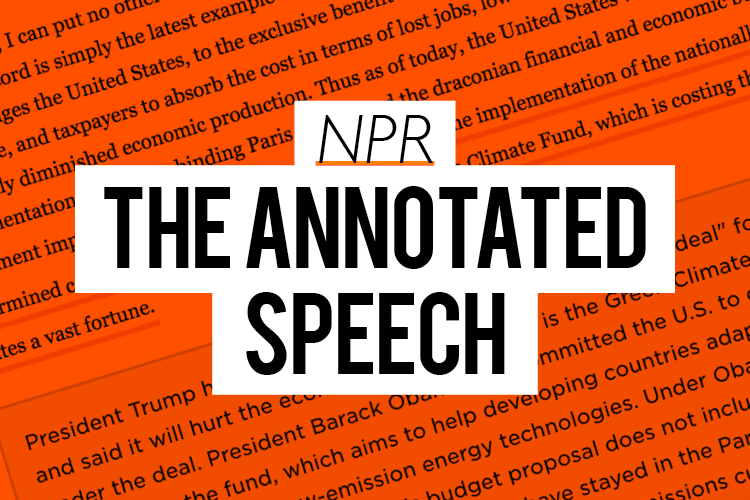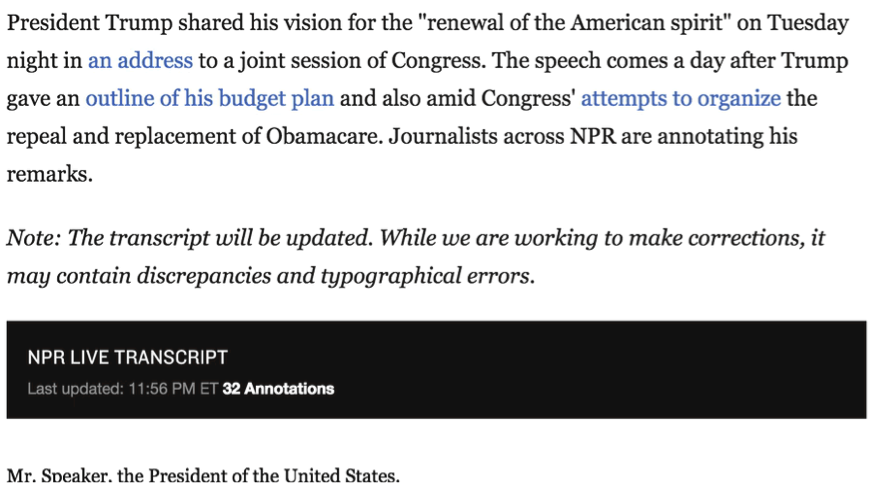
The annotated speech
Creator: National Public Radio
Summary: Live annotations and fact-checking of political speeches.
_____________________________________________
During the height of the 2016 elections and its firehose of nonstop news, NPR wanted a better way to cover live speeches and debates.
At the same time, NPR was looking for a way “to elevate the prominence and usefulness of our fact-checking operation,” said Tyler Fisher, then a news app developer on NPR’s visuals team.
The visuals and politics teams developed a pared-down version of their current annotated speech process and test-drove it during the Republican and Democratic conventions. Reporters hand-transcribed speeches and annotated them using simple cascading stylesheets (CSS) built by the visuals team.
The annotated speech approach proved to be one of NPR’s most-read examples of non-traditional presentations.
“Taken together, our annotations for the debates are NPR.org’s most successful digital project of all time. We received more traffic to these than to any other project NPR has ever done,” Fisher says. Since then, non-election annotations also have fared well.
“But we’re pleased with the performance of these for reasons beyond traffic. We see higher completion rates (scrolling to the bottom of the page) than we see on typical stories, even when the transcripts are quite long. Similarly, we see a much higher time on page with these than with other content.”
Working with Fisher were David Eads, Wes Lindamood, Katie Park, Juan Elosua and Clinton King on the visuals team; and Beth Donovan, Amita Kelly and Domenico Montanaro on the politics team.
For the debates, the team wanted to take the structure to the next level, hiring a transcription service so that a team of reporters could focus their efforts on annotation, which got extra development attention from the visuals team. (See technical details below). Then, instead of assigning staffers to multiple issue-based stories on debate night, teams of reporters worked together on the live annotation so the multi-pronged context of the speech was contained all in one place.
Fisher’s former editor David Eads (now with ProPublica) calls such formats “turning spectacle into evidence” — taking primary-source material like a live speech or debate and turning it into a rolling resource of facts for readers.
In an era of increasing outcry over fake news, primary-source forms provide transparency for readers.
“Something that connects many of these alternative story forms — transcripts, annotated tweets, promise tracking, etc. — is that it inverts the relationship between reportage and primary-source material,” Fisher says. “In these cases, the primary source leads, and our annotation and reportage accompany.
“We think this provides a better sense of context and makes our work more reputable. With so much about news and basic facts being questioned, being as clear as possible about your sourcing is integral to building audience trust.”
NPR’s newsroom and others often ask about reusing the annotation style or other explanatory forms the visuals team has developed, but Fisher underscores the importance of tailoring the format to the needs of a particular story.
“When it came to President Trump and his ethical conflicts of interest, we did it by tracking the promises he made. When it came to President Trump’s Twitter account, we did it by annotating the tweets individually and then collecting them into one resource,” he says, noting the value of a visuals team “that can bring design thinking to every situation.”
Alternative story forms — the term Fisher uses to describe non-narrative forms — can also be difficult to promote since social networks don’t respond well to the same link being posted on repeat. And as information is added to expandable resources such as NPR’s log of President Trump’s annotated tweets, it takes extra work to direct readers to the newest information when they click, Fisher says.
Despite the hurdles, Fisher says, “The feedback we get from our audience is in line with where we want the NPR brand to be in the news consumer’s mind. We see fact-checking, annotation and full context as key pieces that define NPR’s digital news presence.”
Technical points and modifications: Fisher described the development of the annotated speeches in a blog post: “The system we built ingests a caption feed and dumps the feed into a Google Doc. Dozens of our reporters and editors are in that document, ready to annotate it. We then transform the Google Doc into HTML suitable for our live web page.”
Alternative story forms can present challenges to newsrooms, Fisher says, since they often require different structures for collaboration that exist outside the typical workflow. “Sometimes, reporters are writing in a Google Doc, sometimes in spreadsheets, sometimes in Django,” a web framework.
This takes reporters “out of their normal flow,” he said. “Unless you build deeply into your own CMS, that will always be a struggle.”
Web annotators such as Genius and Hypothes.is are another way for news organizations to offer straightforward notations. When The Washington Post’s Chris Cillizza — now at CNN — first began experimenting with Genius, he said such tools “hold almost limitless potential as a new avenue by which journalists can add value.”
Share with your network
- Recoding journalism: Some ideas to get started
- NPR: The annotated speech
- Purple: The Political Messenger
- Los Angeles Times: Story stacks
- Baltimore Sun: ‘Dismissed’: Focused on solutions
- Washington Post: Tracking Trump
- Asheville Citizen-Times: Explaining redistricting
- ProPublica: A tweetstorm of facts
- New York Times: Visualizing America’s problems
- Axios: ‘Smarter Faster’ videos
- A portfolio of examples
- Tampa Bay Times: The LEGO Project
- Wall Street Journal: Charting stock and tweets
- Improving accountability reporting: How to make the best of journalism better for audiences
- Your turn
You also might be interested in:
Successfully and efficiently marketing your work can be hard, especially for local news teams with limited resources, but marketing yourself to your audience is an essential skill for news organizations to drive revenue and promote sustainability.
As news teams begin thinking about their election coverage plans, it may feel like adding more tasks to an already full plate, with a fraction of the staff and resources they once had. But that doesn’t have to mean figuring out how to do more with less — maybe it’s doing less with less.
We reached out to Danielle Coffey, the CEO of American Press Institute’s parent corporation, the News/Media Alliance, to learn more about the legal fight for news organizations’ rights with AI.



